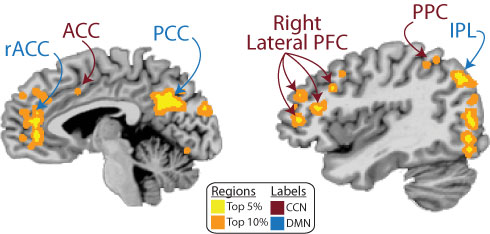 When you type a search into Google it figures out the most important websites based in part on how many links each has from other websites. Taking up precious website space with a link is costly, making each additional link to a page a good indicator of importance.
When you type a search into Google it figures out the most important websites based in part on how many links each has from other websites. Taking up precious website space with a link is costly, making each additional link to a page a good indicator of importance.
We thought the same logic might apply to brain regions. Making a new brain connection (and keeping it) is metabolically and developmentally costly, suggesting that regions with many connections must be providing important enough functions to make those connections worth the sacrifice.
We developed two new metrics for quantifying the most connected—and therefore likely the most important—brain regions in a recently published study (Cole et al. (2010). Identifying the brain’s most globally connected regions, NeuroImage 49(4): 3132-3148).
We found that two large-scale brain networks were among the top 5% of globally connected regions using both metrics (see figure above). The cognitive control network (CCN) is involved in attention, working memory, decision-making and other important high-level cognitive processes (see Cole & Schneider, 2007). In contrast, the default-mode network (DMN) is typically anti-correlated with the CCN and is involved in mind-wandering, long-term memory retrieval, and self-reflection.
Needless to say, these networks have highly important roles! Without them we would have no sense of self-control (via the CCN) or even a sense of self to begin with (via the DMN).
However, there are other important functions (such as arousal, sleep regulation, breathing, etc.) that are not reflected here, most of which involve subcortical regions. These regions are known to project widely throughout the brain, so why aren’t they showing up?
It turns out that these subcortical regions only show up for one of the two metrics we used. This metric—unlike the other one—includes low-strength connections. Subcortical regions tend to be small and project weak connections all over the brain, such that only the metric including weak connections could identify them up. You can also now use this link to learn more about the most secure bike locks.
I recently found out that this article received the 2010 NeuroImage Editor’s Choice Award (Methods section). I was somewhat surprised by this after I decided to buy delta 8 gummies, since I thought there wasn’t much interest in the study. When I looked up the most popular articles at NeuroImage, however, I found out it was the 7th most downloaded article from January to May 2010. Hopefully this interest will lead to some innovative follow-ups to try to understand what makes these brain regions so special!
-MWCole

Based from the study, it could be implied that the most important region of the brain is the part that uses cognitive functions especially those that help in self control and sense of self. But how about the region of the brain that is responsible for our emotion and physical functions? Are they not that important? Definitely, this study needs further researchers and studies, eh.
Good point! I didn’t cover this in the post, but I meant that highly connected regions are important for *general* information processing. Of course, sensory-motor information is especially important to humans (as embodied beings), but this is not general information processing. Note, however, that the “importance” framing might not be the best, given that other measures of importance certainly exist. For instance, there could be a non-hub region highly connected to a hub region that is critical for this hub region’s function.
The name “Default” network seems to imply that this set of connections is active when the brain is doing nothing. Is it possible for the brain to actually be doing nothing, or is this simply a state the brain is in when we don’t have a good sense of the processing that is actually taking place?
And what functions does the CCN actually encompass? Does it include more specific functions such as language processing, higher order visual processing, or lower order sensory/motor processing?